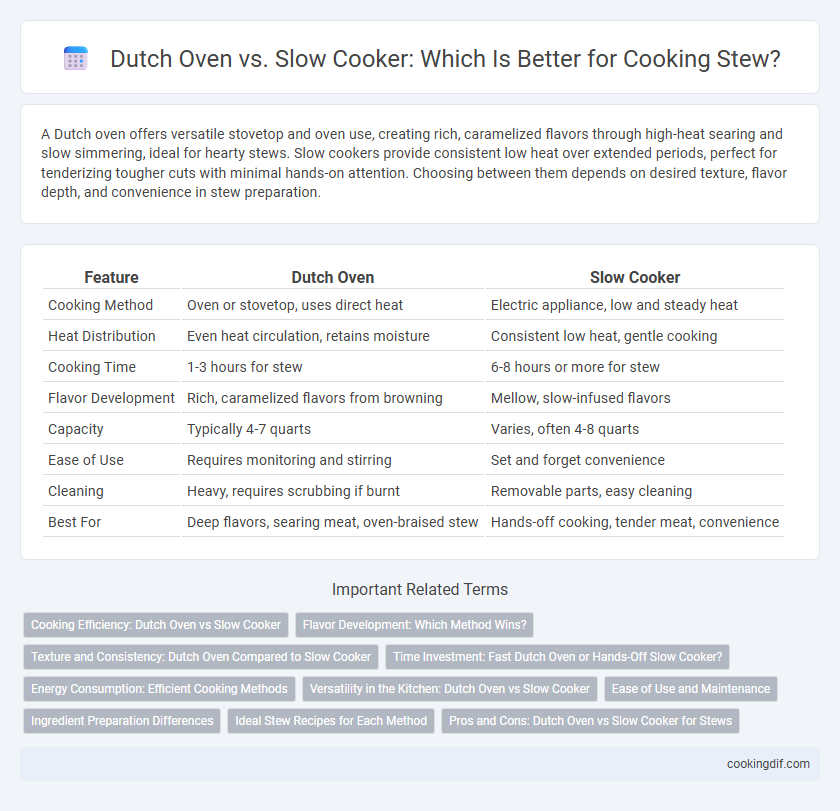A Dutch oven offers versatile stovetop and oven use, creating rich, caramelized flavors through high-heat searing and slow simmering, ideal for hearty stews. Slow cookers provide consistent low heat over extended periods, perfect for tenderizing tougher cuts with minimal hands-on attention. Choosing between them depends on desired texture, flavor depth, and convenience in stew preparation.
Table of Comparison
| Feature | Dutch Oven | Slow Cooker |
|---|---|---|
| Cooking Method | Oven or stovetop, uses direct heat | Electric appliance, low and steady heat |
| Heat Distribution | Even heat circulation, retains moisture | Consistent low heat, gentle cooking |
| Cooking Time | 1-3 hours for stew | 6-8 hours or more for stew |
| Flavor Development | Rich, caramelized flavors from browning | Mellow, slow-infused flavors |
| Capacity | Typically 4-7 quarts | Varies, often 4-8 quarts |
| Ease of Use | Requires monitoring and stirring | Set and forget convenience |
| Cleaning | Heavy, requires scrubbing if burnt | Removable parts, easy cleaning |
| Best For | Deep flavors, searing meat, oven-braised stew | Hands-off cooking, tender meat, convenience |
Cooking Efficiency: Dutch Oven vs Slow Cooker
Dutch ovens provide superior heat retention and even heat distribution, allowing for higher cooking temperatures and better caramelization in stews compared to slow cookers. Slow cookers operate at low, consistent temperatures over long periods, enhancing tenderization but often lacking the depth of flavor achieved through the browning stages possible with a Dutch oven. For cooking efficiency, Dutch ovens offer faster cooking times and versatile stovetop use, while slow cookers excel in unattended, energy-efficient cooking.
Flavor Development: Which Method Wins?
Dutch ovens excel at flavor development in stews due to their ability to evenly distribute heat and create a sealed environment that enhances caramelization and Maillard reactions, resulting in deeper, richer flavors. Slow cookers, while convenient for long, low-temperature cooking, often produce milder, less complex flavors because they lack the intense searing and moisture control found in Dutch ovens. Culinary experts generally prefer Dutch ovens for achieving robust, well-developed stew flavors.
Texture and Consistency: Dutch Oven Compared to Slow Cooker
The Dutch oven produces a richer, more complex texture due to its ability to maintain high, consistent heat and allow for better caramelization and browning during cooking. Slow cookers yield a softer, often more uniform texture as they cook at lower temperatures for extended periods, which can sometimes cause vegetables and meats to become overly mushy. For stew, a Dutch oven's ability to develop depth in texture and consistency often results in a heartier, more robust dish compared to the mild softness typical of slow-cooked meals.
Time Investment: Fast Dutch Oven or Hands-Off Slow Cooker?
Dutch ovens offer a faster cooking time by providing high, consistent heat ideal for browning and simmering stews within 2 to 3 hours. Slow cookers require a longer time investment, typically 6 to 8 hours on low, allowing for hands-off, gradual heat that tenderizes meat and blends flavors over time. Choosing between these methods depends on your schedule and preference for active cooking versus convenience.
Energy Consumption: Efficient Cooking Methods
Dutch ovens offer efficient heat retention and distribution, allowing stews to cook evenly on low heat with minimal energy use. Slow cookers consume consistent low wattage over extended periods, providing energy savings by maintaining a steady temperature without frequent heat spikes. Choosing between them depends on cooking style, but both methods optimize energy consumption for slow-cooked stews.
Versatility in the Kitchen: Dutch Oven vs Slow Cooker
The Dutch oven offers exceptional versatility for stews, allowing searing, stovetop cooking, and oven braising all in one vessel, which enhances flavor development through controlled heat. Slow cookers excel in convenience, providing low-and-slow cooking with minimal supervision and consistent temperature control, ideal for tenderizing tougher cuts of meat. Both methods deliver rich, flavorful stews, but the Dutch oven supports more diverse cooking techniques, making it a valuable multitasker in the kitchen.
Ease of Use and Maintenance
Dutch ovens offer versatile stovetop and oven use with straightforward cleaning due to their sturdy cast iron construction and enamel coating, which resists staining and retains heat efficiently. Slow cookers provide user-friendly, set-it-and-forget-it operation with programmable timers and removable ceramic inserts that are dishwasher safe, simplifying maintenance. Both methods require minimal hands-on attention, but slow cookers excel in convenience, while Dutch ovens require occasional seasoning if uncoated.
Ingredient Preparation Differences
Dutch oven cooking for stew requires chopping ingredients into uniform, often larger pieces to ensure even heat distribution and caramelization during stovetop searing and oven braising. Slow cooker recipes favor smaller, more evenly sized cuts to promote thorough, low-temperature cooking over several hours, allowing flavors to meld without burning. Ingredient preparation in Dutch oven methods emphasizes browning and layering, while slow cooker preparation focuses on ease and consistent cooking texture.
Ideal Stew Recipes for Each Method
Dutch ovens excel at delivering rich, deeply flavored stews due to their ability to maintain consistent, high heat and create a perfect braising environment for tougher cuts of meat like chuck or short ribs. Slow cookers are ideal for convenience and long, low-temperature cooking, making them perfect for recipes with delicate vegetables and less intensive stirring, such as chicken or vegetable stews. Both methods enhance tenderness and flavor but choosing between them depends on desired texture, cooking time, and recipe complexity.
Pros and Cons: Dutch Oven vs Slow Cooker for Stews
Dutch ovens excel at high-heat searing and even heat distribution, resulting in rich, deeply flavored stews with a tender texture. Slow cookers offer convenience with set-and-forget functionality, maintaining low, consistent temperatures ideal for long-simmered, hands-off stew preparation. Dutch ovens require more active monitoring and stove or oven usage, while slow cookers lack the initial browning capability but provide energy-efficient, all-day cooking without supervision.
Dutch oven vs slow cooker for cooking method Infographic

 cookingdif.com
cookingdif.com